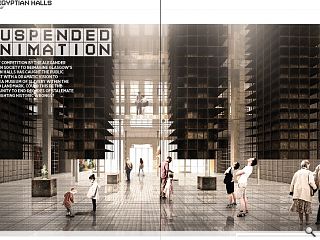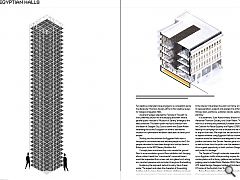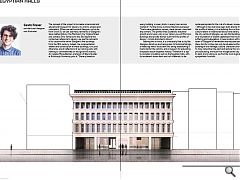The Egyptian Halls: Suspended Animation
22 Jul 2020
A timely competition by the Alexander Thomson Society to reimagine Glasgow’s Egyptian Halls has caught the public zeitgeist with a dramatic vision to fashion a museum of slavery within the A-listed landmark. Could this be the opportunity to end decades of stalemate while righting historic wrongs?
Two leading contenders have emerged in a competition led by the Alexander Thomson Society (ATS) to find creative reuses for Glasgow’s Egyptian Halls.
A panel of judges selected the ‘Temple of Thought’ as their preferred solution for the decaying landmark while a parallel public vote saw a ‘Museum of Slavery’ emerge as the lead contender. This latter option has found traction from the leader of Glasgow City Council down with Susan Aitken reiterating the council’s support for either a standalone museum or a permanent exhibition dedicated to slavery and empire.
Slotting into this ambition the Egyptian Halls work is designed to commemorate and educate people on the 3.5m people estimated to have been bought and sold as slaves in Britain prior to the 1833 Slavery Abolition Act.
Concept plans would see shop units vacate the ground floor to accommodate a ground floor exhibition hall. Hanging above visitors heads four ‘monumental’ memorial towers would be suspended from a new cast iron glazed roof, acting as a constant presence and reminder throughout the building.
In a statement, Scott Abercrombie, director of the Alexander Thomson Society, told Urban Realm: “We think that this is a timely and potentially fundable solution, but the Coalition for Racial Equality and Rights (CRER) has been leading this campaign for over a decade and we don’t want to step on their toes. We hope that we can work with CRER to explore whether using Egyptian Halls as a home for their museum would be viable and are delighted to hear the initially positive comments that Zandra Yeaman gave us for our article, as well as those from the public over the weekend who think this is a great opportunity to both confront Glasgow’s history and protect its heritage.”
The Temple of Thought contender meanwhile picks up on Egyptian motifs while providing a space for quiet contemplation with a library, galleries and exhibition halls. The judging panel included Robin Webster, RIAS; Mark Baines, ATS; Isabel Garriga, Glasgow Institute of Architects and Susan O’Connor of the Scottish Civic Trust.
Below Fraser talks us through his winning entry while efforts get underway to make it a reality.
Gavin Fraser, architectural designer
and illustrator
The concept of the project is to create a memorial and educational museum for slavery, its victims, empire and colonialism. When we walk around Glasgow, not so far from Union St, we can see many remnants of Glasgow’s slave related history; the Merchant city, Virginia Street and Jamaica St to name but a few. But beyond this contextual reference to slavery, we see the remnants of its lucrative life within Glasgow’s fine buildings from the 19th century. Indeed, the ornamentation, wealth and construction of these buildings, civic and otherwise, are all reflections of our slaving past, with nothing to commemorate or recognise this history. As Celeste-Marie Bernier, professor of Black Studies at Edinburgh University puts it; “Slavery bleeds in every building, in every brick, in every town across Scotland.” Furthermore, as David Hayman expresses: “Scots were plantation owners, slave owners, merchant ship owners. The profits fired Scotland’s industrial growth and in every city in our nation you will find civic buildings and private homes built from the profits of slavery – bricks drenched in blood.”
Bearing this in mind, it is a necessity that a city like Glasgow stands up and recognises its historical failings, a means by which to achieve this being establishing a memorial for the victims, and a museum for educating the public about forgotten history. Therefore it is apt to consider a building such as the Egyptian halls, with its exuberant stone-work and rich materials, to be quite appropriate for the role of a slavery museum – although it may not have been built directly from the profits of slavery, it is a building from a time and culture reliant of indentured labour and slavery. Within the city centre of Glasgow, we can find buildings built on a foundation of wealth capitalised from human suffering and subjugation. A new location within the heart of Glasgow to remember and educate about these horrific crimes can only be situated within a building of this heritage, culture, character and history. To truly remember the past and restore this once proud building, we must first recognise the city and its past, and in doing so we find the most logical and sympathetic function.
|
|





